One of the most enchanting industries in Southeast Asia is also one of the most lucrative: the natural rubber industry. Thailand is currently the world’s biggest producer of natural rubber, and in 2010 was one of eleven countries that produced 92% of global natural rubber. Unlike most of the rubber used in the worldwide market today, natural rubber is made from liquid latex tapped from para rubber trees (Havea brasiliensis). The liquid latex is then mixed with a diluted acid (often formic acid) and then rolled—after hardening—into a flexible white sheet. What struck me most about this process was the beauty of the latex tapping. A sharp hooked knife is used to cut a diagonal strip of bark back from the tree in order to allow the sap to flow. Even more interestingly, this is usually done at night just a few hours before dawn, as this is the time the latex sap flows the easiest. Tappers use headlamps in order to see in the dark rubber forests.
Para rubber trees are not indigenous to Thailand, however, and many environmentalists fear that their excessive use of water and shallow root systems are damaging to the environment. Furthermore, the price of rubber has decreased in recent years, and many people are using the rubber trees for a different purpose: wood. Kiln-dried rubber wood lumber is increasing in export value, and it is very common to see 1-3m long para rubber wood logs being trucked away to sawmills, white latex seeping from the tree rings. One of the most beautiful things about the para rubber industry is the innovation implemented by the Thai community—the idea that an object can serve many uses, and a community can adapt to a changing market. Because Thailand’s economy relies heavily on its exports, the ability to adapt is crucial for para wood farmers.
-
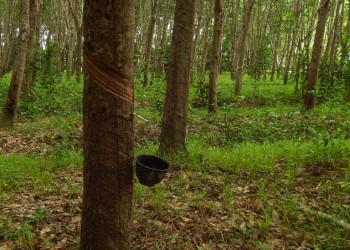
First Light
New Trees beginning to be tapped for latex sap are planted in rows, common for monoculture cropping. The natural rubber as well as logging industries are staples of the Thai economy, both utilizing the para rubber tree, Havea brasiliensis (Matan 2016).
-
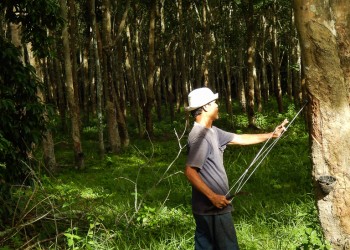
Early Morning Work
A rubber tapper tends to his trees in the early morning, after which his wife empties the latex from the cups into a bucket. Later, the rubber will be processed and sold. The majority of rubber plantations are in the south of Thailand, where there is ample land for planting.
-

Tools of the Trade
A rubber tapper in Tha Sala, Nakhon Si Thammarat holds one of the only tools necessary for his trade: a sharp hooked knife to be used to make incisions in the tree’s bark. White latex sap can be seen coating his fingers from the day’s work. Each tree typically produces a few ounces of latex sap per day.
-

Monocrop
The diagonal lines seen on these para rubber trees come from the process of tapping it for latex, the white sap dripping from the tree. The latex is later used to make natural rubber.
-
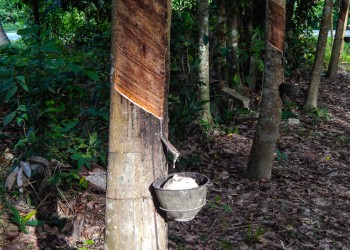
Tapped Tree With Full Cup
Thailand is the world’s largest exporter of natural rubber, although its use has been falling behind that of synthetic rubber in recent years. As one can see, the cup is full of hardened latex: it has not been harvested. This tree will likely be cut down and logged, as para rubber wood’s exporting value surpasses natural rubber’s (Matan 2016).
-

Healed Bark
The darker portion of the tree’s bark has been tapped and given time to heal over. Rubber tappers will alternate cutting sides of the tree in order to give the tree time to heal intermittently, elongating its lifetime (Matan 2016).
-

Processing Rubber
After tapping his trees and emptying his cups, the para wood farmer mixes the latex with formic acid and water, allows it to settle, kneads it, and runs it through a rubber rolling machine. The whole process post-tapping takes only about an hour.
-
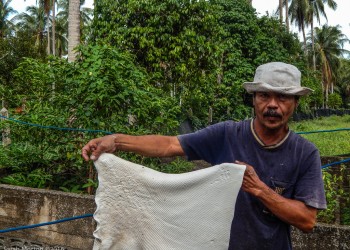
A Finished Product
After rolling the processed rubber, it is hung to dry. The rubber will then be sold to make products like shoes, hoses, and tires.
-

Log Runner
While a knife is the essential tool for a rubber tapper; rubber loggers use something quite different: an elephant. After the trees are cut down with a saw, an elephant that has been outfitted with chains is used to drag them to the base of the mountain.
-

Stacking Wood
Once the logging elephant has brought the lumber to the base of the mountain, he crouches forward and uses the front of his head and trunk to nudge the trees into a neat pile, all the while being directed by his owner. Logging elephants cost around 1.5 million Baht (around 40,000 USD) (Boonkaew 2016).
-

A Versatile Commodity
A para rubber tree is logged, chopped down and cut into 1-3 m segments to be carried to a sawmill and used for various wood products, including furniture. The stump of a larger rubber tree can be seen next to the wood segment, and an old latex collecting cup, no longer in use. It is becoming more and more common for rubber farmers to switch to logging, using the trees for their wood rather than their latex (Matan 2016). As a result, vast fields of logged rubber trees—segments, stumps, and out of use cups—can be seen where forests used to be.
-
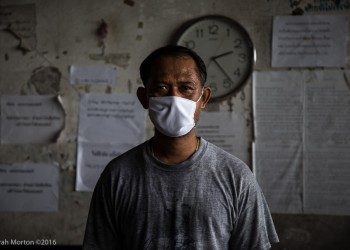
Portrait of a Sawmill Worker, 2:23 pm
A sawmill employee stands momentarily as I take his photo, his shirt stained a darker grey from sweat and his mask pulled up over his nose. Inside the sawmill there is no AC, and appear to be very few if any regulations. The only visible health precaution is the white surgical masks to prevent respiratory damage from inhalation of particulate matter, in stark contrast to Western occupational hazard protocol.
-
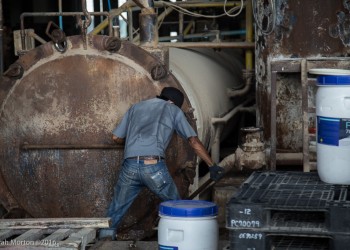
Cog
A sawmill employee tightens the bolts on a machine as his colleagues operate bandsaws and drive trucks of logged wood, working as a well-oiled machine themselves. The employees here are hard workers, performing manual labor as well as working intricate machinery. They talk amongst themselves happily, everyone appears to be in good spirits.
-
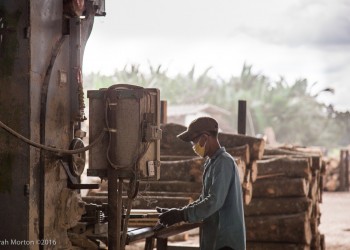
Inside the Sawmill
A sawmill worker operates a band saw as he shaves down logs of para wood. After this, they will be chemically treated with preservatives and dried in a kiln (Matan 2016).
-
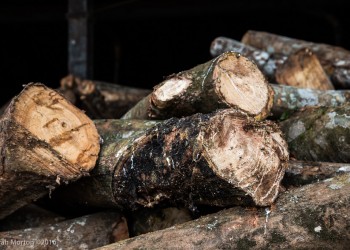
Detail of Logs with Latex
Once para rubber trees have been logged and weighed, they are placed into a pile in front of the sawmill, where they await being processed and kiln-dried. Latex can be seen dripping from the tree stumps, a relic of para rubbers’ former industry.
-
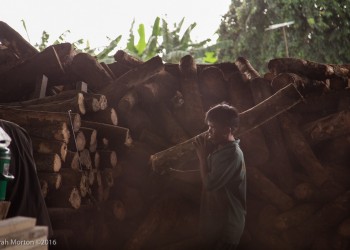
Lumber
After being cut down, para rubber trees are then cut into segments 1-3 meters long in order to be carried through the mill and loaded into trucks more easily. The trucks are then driven onto scales embedded into the floor of the mill where the wood is weighed.
-
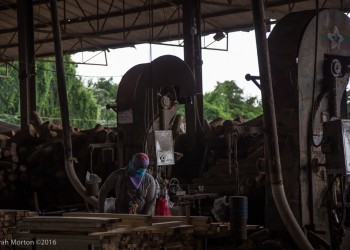
Woman with Bandsaws
A woman loads planks of wood into a pile after operating a bandsaw. There are easily as many women as men working, although most of them work sorting planks of the sawed wood in the back of the mill while men load the freshly logged wood.
-
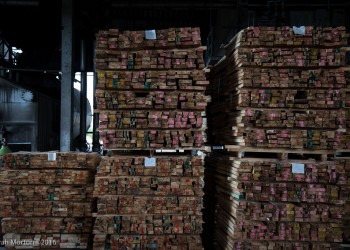
Kiln-Dried Wood
The final product of Havea brasiliensis lumber, kiln-dried wood is increasingly being manufactured in Thailand. Export value of kiln-dried wood lumber has increased by about 3 times from 2005-2014. Most kiln-dried lumber is exported to China. This is one link between the Thai and Chinese economies. (Matan 2016).
-
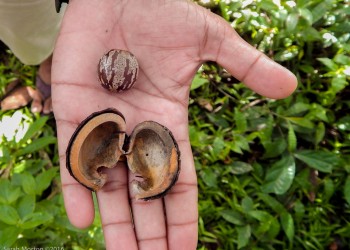
Para Rubber Seed
The para rubber tree is not indigenous to Thailand. Seeds were brought to Asia by English botanist and geologist Henry Ridley in order to be planted in British colonies. Some ecologists now fear the consequences of introducing an invasive species, particularly because of the trees’ high demand for water (Matan 2016).
Sources
AZoM. “Natural Rubber / Latex – Production of Natural Rubber.” AZoM. AZO Materials, 09 Nov. 2006. Web. 28 July 2016.
Matan, Nirundorn, Dr. “Thai Rubberwood Lecture.” Walailak University, Tha Sala, Nakhon Si Thammarat, Thailand. July 2016. Lecture.
Boonkaew, Sunthorn. Head of Tourism and Hospitalisty Program, School of Management, Walailak University.


















